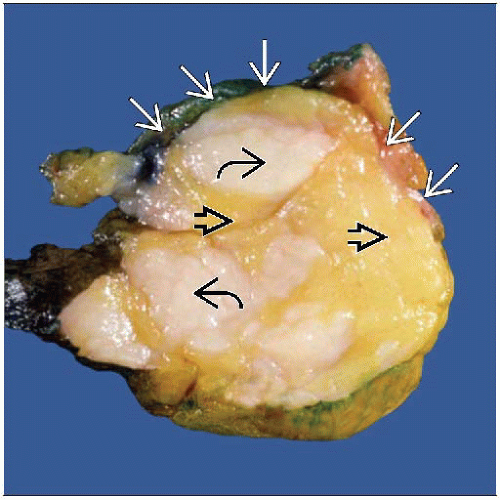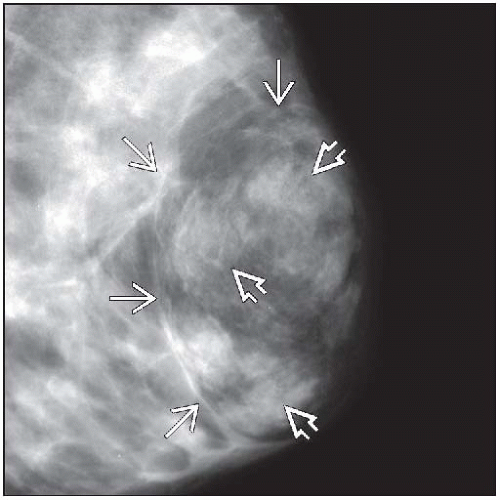Hamartoma (Fibroadenolipoma)
Key Facts
Terminology
Mammary hamartoma (MH)
Synonyms: Fibroadenolipoma, adenolipofibroma
Well-circumscribed mass, disorganized overgrowth of mature benign mammary tissues
Variously composed of ductal and lobular epithelium and stromal mesenchymal elements
Clinical Issues
Reported incidence of 0.1-0.7%
Benign lesion
Consider surgical excision for symptomatic cases or atypical appearance
Image Findings
Classic appearance has been described as “breast within a breast” on mammogram
Macroscopic Features
Cut surface shows variable fat and fibrotic stroma
Microscopic Pathology
Stroma of MH can consist of a variety of different mesenchymal tissues
Different stromal elements can coexist in single lesion
Adipose tissue is typically seen in variable amounts
Cases with prominent myoid changes are referred to as myoid hamartomas
Typical lesions will show glands that resemble normal terminal ductal lobular units
Top Differential Diagnoses
Fibroadenoma
Benign phyllodes tumor
TERMINOLOGY
Abbreviations
Mammary hamartoma (MH)
Synonyms
Fibroadenolipoma, adenolipofibroma
Definitions
Hamartomas, distinct subtype of benign tumors
Proliferation of cells that show normal differentiation but are disorganized with respect to architecture
MHs are well-circumscribed lesions composed of a disorganized overgrowth of benign mammary tissues
Variously composed of ductal and lobular epithelium and stromal mesenchymal elements
Typical MH shows considerable overlap with other benign breast lesions
ETIOLOGY/PATHOGENESIS
PTEN Hamartoma Tumor Syndromes
MHs are more commonly observed in patients with dysgenetic disorders such as Cowden syndrome
Cowden syndrome is autosomal dominant disorder associated with increased risk of developing benign and malignant tumors
Breast, thyroid, skin, central nervous system, and GI tract are most frequently affected
Solitary MHs are associated with Cowden syndrome
Cowden syndrome is caused by germline mutation in tumor suppressor gene PTEN
Loss of PTEN increases activation and signaling of PI3K/Akt/mTOR pathway
MHs probably result from dysgenesis of mesenchymal cells leading to abnormal growth resulting from this altered cellular signaling
CLINICAL ISSUES
Epidemiology
Incidence
MH has a reported incidence of 0.1-0.7%
Many authors consider this entity underdiagnosed
Findings in some MHs may be misinterpreted as other benign lesions
Age
Range is wide (20-80 years)
Mean age: 45 years
Gender
Almost exclusively seen in female patients
Presentation
Typical patient will present with painless, soft to firm, palpable breast mass
Clinical impression is often that of fibroadenoma
May be detected on screening mammogram
MHs may be solitary or multiple
May occur in ectopic breast tissue in axillary or inguinal areas










